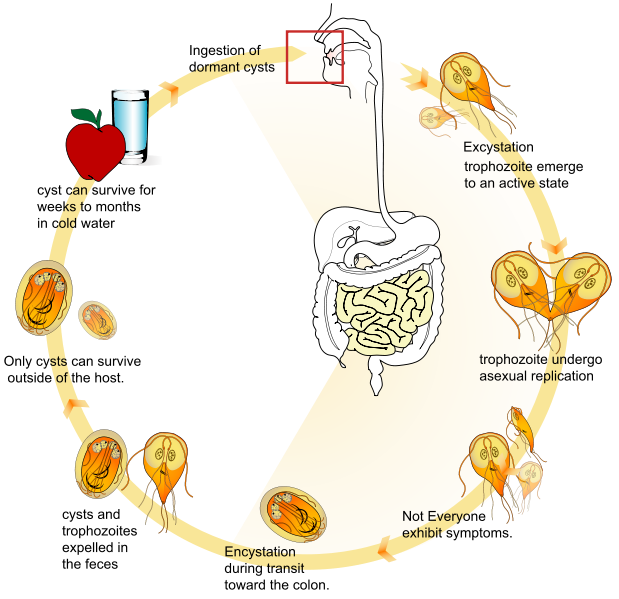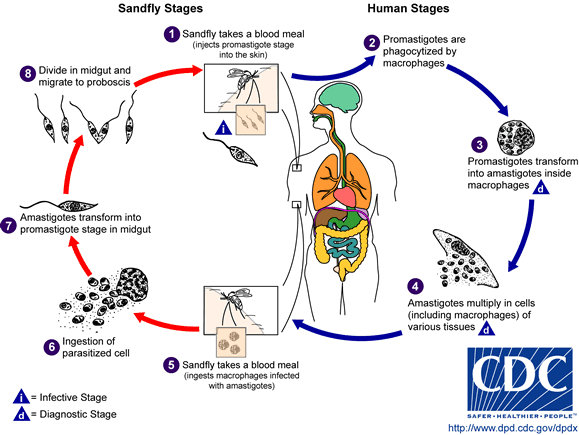Cards In This Set
| Front | Back |
|
Protozoans
|
Unicellular Organism
|
|
Protozoa
|
Eukaryotic- unicellular, usually motile, lack a cell wall- distinct from bacteria (prokaryotes), viruses and prions (acellular)
- drug development for pathogenic protozoa difficult Complex Life Cycles - insect and mammalian stages Reproduction 1. Asexual: mitosis followed by cytokinesis2. Sexual: exchange of of genetic information between protozoa of opposite mating types |
|
Diseased Caused by Eukaryotes
|
- Parasitic Protozoa (ex. Giardia)
|
|
Cysts vs. Trophozites
|
1) Cyst: "resting" form of the parasite- parasite enveloped in a cyst wall- Cyst functions: 1. provides protection from changes in environment 2. low metabolic activity 3. allows for transfer from one host to another- Encystation - formation of a cyst- Excystation - escape from the cyst; triggered by return to a favorable environment of by entry into a new host
2) Trophozoite: active, vegetative (capable of growth) form of the parasite |
|
Transmission of Protozoan Diseases
|
1) Food and water-borne protozoan infections:
- Toxoplasma (tissue cysts in meat)- Entamoeba (cysts in water) -Giardia (cysts in water) 2) Vector-borne protozoan infections:- Plasmodium (mosquito)- T.brucei (tsetse fly)- T.cruzi (triatomine "kissing" bug)- Leishmania (sand fly) 3) Sexually transmitted protozoan infections:- Trichomonas |
|
Categories of Protozoans
|
1) Kinetoplastids: a group of single-cell flagellate protozoa- Leishmania spp.- Trypanosoma brucei- Trypanosoma cruzi
2) Apicomplexans: an apical complex structure- cryptosporidium- toxoplasma- plasmodium 3) Others:- Trichomonas- Entamoeba- GIARDIA |
|
Giardiasis
|
- intestinal disease caused by G. intestinalis- found worldwide- most common cause of waterborne diarrheal illness in the US (30,000 cases annually)- Transmission: 1. Cyst-contaminated water 2. Numerous animal reservoirs 3. Aysmptomatic human carriers (and shedders) are common: ~7% population
|
|
Life Cycle of Giardia intestinalis
|
 |
|
Pathogenesis of Giardia intestinalis
|
- "traveler's diarrhea"- causes intestinal disease in humans and animals. - cysts cause infection then differentiate into trophozoites- trophozoites attach to intestinal epithelium of the small intestine and interfere with nutrient absorption
Pathology: villus atrophy and crypt hyperplasia Protective host immunity?- Giardia undergoes antigenic variation - the mechanism which infectious organism alters its surface proteins in order to evade a host immune response - Immunity is genetic |
|
Symptoms, Prevention, Treatment
|
Clinical manifestations:1. acute giardiasis - severe diarrhea, epigastric pain, cramps2. chronic gastritis - intermittent diarrhea with periodic appearance and remission of symptoms
Prevention, treatment, and control:- Avoid contaminated water- use filters, boiling, or iodine to treat drinking water- antiprotozoal agents can be used to treat infection |
|
Hemoflagellate/Kinetoplastids Diseases
|
- blood infections caused by flagellated protozoa (also called kinetoplastids): - Leishmania spp. - Trypanosoma spp.- Complex life cycle involves vertebrate (often mammalian) and invertebrate (insect) hosts- Transmitted by bites of infected arthropods (arachnids, crustaceans, insects etc- infect blood and tissues of humans
|
|
Kinetoplastids
|
Kinetoplast - specialized DNA-containing organelle located in the mitochondrion of a kinetoplastids. It contains catenated kDNA circles(looks like chain-linked DNA within that site) the encode proteins involved in mitochondrial energy production.
- catenated kDNA circle: this is one aspect of these parasites that is distinct from us, can be used as a potential target for drugs |
|
Leishmania Life Cycle
|
 Promastigote: often refers to insect stage Amastigote: often refers to intracellular life cycle in the mammalian host |
|
Leishmania
|
- Leishmania: flagellated protozoa- Cause different forms of human leismaniasis: cutaneous (skin) and visceral (internal organs)- Transmitted by sand flies when they take a blood meal; primary reservoirs are canines and rodents;sand flies transmit disease from animals to humans and from humans to humans
- sand flies are ~1/3 the size of mosquitoes- during feeding, sand flies introduce parasites into the skin- parasites are taken up by macrophages, where they replicate and spread |
|
Clinical Leishmaniasis
|
- Cutaneous/ Skin form (most common): 1. Mucocutaneous: lesion of mouth, nose, throat, and skin that cause extensive scarring and disfigurement. Destruction of nasal septum and causes deformity in nose and lip 2. Diffuse Cutaneous: papules at each inoculation site develop into crustated ulcers; healing occurs with scarring
- Visceral form: - infected marcrophages lodge in body tissues, lyse, and amastigote release continues the infection - results in organ and tissue damage -cause fever and enlarged spleen or liver |



